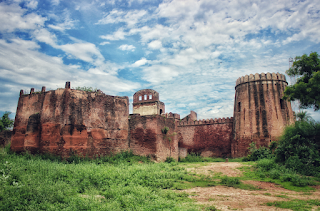SA Site Visit: The Manauli Fort by Trishla Garttan and Rattan Kaur Rainu
 |
| The Manauli Fort, Mohali |
| The present state of decay at Manauli Fort |
As we made our way to site by road, the lack of sign boards leading up to the site made the new batch let out a few gasps This however,came as no surprise to us, the older lot, accustomed as we are now to the habitual disregard that accompanies ‘Protected Monuments’ in the state of Punjab. When someone in the car rolled down the window to ask for directions from a group of locals, they, at first, gazed suspiciously at the vehicle and the people seated in it, until, at last, one person began giving directions. Making our way through a sodden track, from a distance, we saw the ruins of the fort- four rounded towers with pointed barriers at the top, some barbed wires and a vast expanse of thick grass.
The bricks that make up the entire structure, locally referred to as ‘Sirhindi’ bricks, hung loosely from the walls. Some even lay dumped in a corner amidst thick grass. When we got on site, the caretaker informed us that the villagers have picked up some of those bricks and used them in their own constructions. There is, but little comfort in the idea that a part of the history of the fort lives on in the settlements nearby.
| Remains of the Birdari Hall and the Palatial Complex |
As we made our way through thick grass for a closer inspection, each with a clear idea of the duty we were to perform, we noticed the effect of several monsoon downpours, weathering effects and excessive vegetation on the feeble structure. The deep roots of the trees growing inside the fort had widened the cracks in the structure making it lean outwards.This made inspection an even scarier task, for it felt as though the walls could collapse any minute. Arushi from the new batch joked about it being Punjab’s answer to Italy's Leaning Tower of Pisa.
“The structure in its entirety would’ve been three storeys at best,''we proclaimed as we gazed at the broken staircase inside the fort leading to what would’ve been rooms. There were some disfigured tiles on the inside of an arch facing north.
 |
| Extent of Environmental Damage |
From the outside we observed strategically placed holes in the Western walls for placing guns. Interestingly enough, towards one end there were the remains of a mosque. Much of the fort however, remained a riddle as the grass made it impossible to get from one side to the other.
Expecting another downpour, we each began to do our assigned duties. Mayank and Sapna incharge of planning hurried around with measuring tapes, pencils and sheets. Rattan, Trishla and Arushi went about taking pictures, listing site observations as they went about it, our illustrators Manmeet and Kiran began sketching and a buffalo plonked right outside the premises watched in attendance.
 |
| Research Wing Members at Site Recording |
Once the sketches were somewhat complete, things became clearer. What was only being conjectured an hour ago was now on paper. The broken ‘Birdari’ Hall, the Western Gateway, the northern staircase, the water chute and the fountain base all got new life on paper. It was fascinating to witness its splendour even if just on paper.
Seeing there wasn’t much that could be explored of it, we then decided to interview the local population. In our time with Speaking Archaeologically we’ve often explored similar sites where the local population residing in the area is oblivious of the historical narratives that each brick carries with it. What was different about this site you ask? Each villager we spoke to, spoke with such lament, expressing anger and grief at how little the authorities had done to ensure the sustainability of the structure that is such an important part of their heritage. One such person commenting on the government’s casual neglect of his heritage, compared its current state to the permanent disability of a body part.
Despite declaring it a ‘Protected Monument’ almost two decades ago, the state government hasn’t
made any serious efforts to restore it. Leaving aside a few newspaper articles, there are no accessible records of the site. It will only last few monsoons before it gets consumed by the vegetation and another part of Punjab’s rich heritage will be lost and forgotten, like many others, subjected to the same treatment. The site calls for immediate attention! Adaptive reuse, one hopes would breathe new life into this old structure.






Comments
Post a Comment